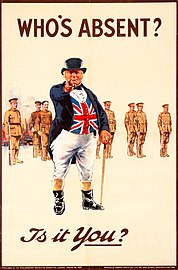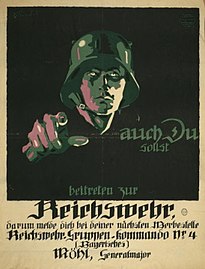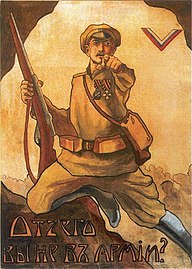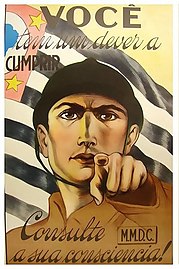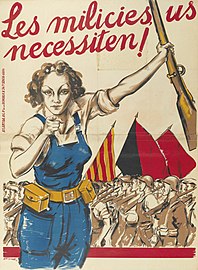
Propaganda is communication that is primarily used to influence or persuade an audience to further an agenda, which may not be objective and may be selectively presenting facts to encourage a particular synthesis or perception, or using loaded language to produce an emotional rather than a rational response to the information that is being presented. Propaganda can be found in a wide variety of different contexts.

Field Marshal Horatio Herbert Kitchener, 1st Earl Kitchener was a British Army officer and colonial administrator. Kitchener came to prominence for his imperial campaigns, his involvement in the Second Boer War, and his central role in the early part of the First World War.
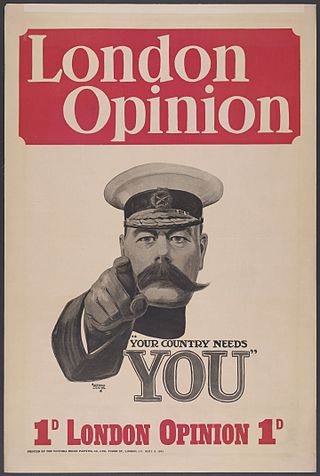
At the beginning of 1914 the British Army had a reported strength of 710,000 men including reserves, of which around 80,000 were professional soldiers ready for war. By the end of the First World War almost 25 percent of the total male population of the United Kingdom of Great Britain and Ireland had joined up, over five million men. Of these, 2.67 million joined as volunteers and 2.77 million as conscripts. Monthly recruiting rates for the army varied dramatically.
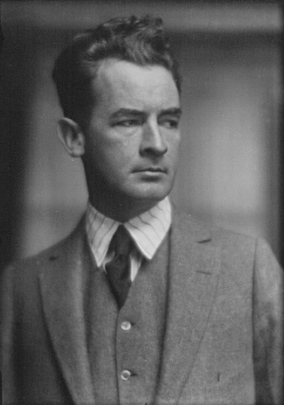
James Montgomery Flagg was an American artist, comics artist, and illustrator. He worked in media ranging from fine art painting to cartooning, but is best remembered for his political posters, particularly his 1917 poster of Uncle Sam created for United States Army recruitment during World War I.

The New Army, often referred to as Kitchener's Army or, disparagingly, as Kitchener's Mob, was an (initially) all-volunteer portion of the British Army formed in the United Kingdom from 1914 onwards following the outbreak of hostilities in the First World War in late July 1914. It originated on the recommendation of Herbert Kitchener, then the Secretary of State for War to obtain 500,000 volunteers for the Army. Kitchener's original intention was that these men would be formed into units that would be ready to be put into action in mid-1916, but circumstances dictated the use of these troops before then. The first use in a major action of Kitchener's Army units came at the Battle of Loos.

Rosie the Riveter is an allegorical cultural icon in the United States who represents the women who worked in factories and shipyards during World War II, many of whom produced munitions and war supplies. These women sometimes took entirely new jobs replacing the male workers who joined the military. She is widely recognized in the "We Can Do It!" poster as a symbol of American feminism and women's economic advantage. Similar images of women war workers appeared in other countries such as Britain and Australia. The idea of Rosie the Riveter originated in a song written in 1942 by Redd Evans and John Jacob Loeb. Images of women workers were widespread in the media in formats such as government posters, and commercial advertising was heavily used by the government to encourage women to volunteer for wartime service in factories. Rosie the Riveter became the subject and title of a Hollywood film in 1944.

The United Kingdom was a leading Allied Power during the First World War of 1914–1918. They fought against the Central Powers, mainly Germany. The armed forces were greatly expanded and reorganised—the war marked the founding of the Royal Air Force. The highly controversial introduction, in January 1916, of conscription for the first time in British history followed the raising of one of the largest all-volunteer armies in history, known as Kitchener's Army, of more than 2,000,000 men. The outbreak of war was a socially unifying event. Enthusiasm was widespread in 1914, and was similar to that across Europe.

Military recruitment refers to the activity of attracting people to, and selecting them for, military training and employment.

Alfred Ambrose Chew Leete (1882–1933) was a British graphic artist. Born at Thorpe Achurch, Northamptonshire, he studied at Kingsholme School and The School of Science and Art in Weston-super-Mare, before moving to London in 1899 and taking a post as an artist with a printer.

Britain re-created the World War I Ministry of Information for the duration of World War II to generate propaganda to influence the population towards support for the war effort. A wide range of media was employed aimed at local and overseas audiences. Traditional forms such as newspapers and posters were joined by new media including cinema (film), newsreels and radio. A wide range of themes were addressed, fostering hostility to the enemy, support for allies, and specific pro war projects such as conserving metal and growing vegetables.

Uncle Sam is a common national personification of the federal government of the United States or the country in general. Since the early 19th century, Uncle Sam has been a popular symbol of the U.S. government in American culture and a manifestation of patriotic emotion. Uncle Sam has also developed notoriety for his appearance in military propaganda, popularized by a famous 1917 World War I recruiting poster by J. M. Flagg.

The First World War, which was fought between 1914 and 1918, had an immediate impact on popular culture. In the over a hundred years since the war ended, the war has resulted in many artistic and cultural works from all sides and nations that participated in the war. This included artworks, books, poems, films, television, music, and more recently, video games. Many of these pieces were created by soldiers who took part in the war.

A poster is a large sheet that is placed either on a public space to promote something or on a wall as decoration. Typically, posters include both textual and graphic elements, although a poster may be either wholly graphical or wholly text. Posters are designed to be both eye-catching and informative. Posters may be used for many purposes. They are a frequent tool of advertisers, propagandists, protestors, and other groups trying to communicate a message. Posters are also used for reproductions of artwork, particularly famous works, and are generally low-cost compared to the original artwork. The modern poster, as we know it, however, dates back to the 1840s and 1850s when the printing industry perfected colour lithography and made mass production possible.
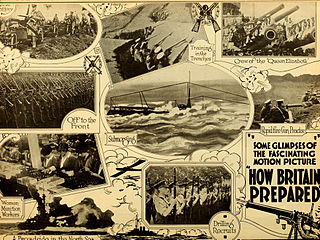
In the First World War, British propaganda took various forms, including pictures, literature and film. Britain also placed significant emphasis on atrocity propaganda as a way of mobilising public opinion against Imperial Germany and the Central Powers during the First World War. For the global picture, see Propaganda in World War I.

"Daddy, What Did You Do in the Great War?" was a British First World War recruitment poster by Savile Lumley, and first published in March 1915 by the Parliamentary Recruiting Committee. It was commissioned and submitted to the committee by Arthur Gunn, the director of the publishers Johnson Riddle and Company. The poster shows a daughter posing a question to her father: "Daddy, what did you do in the Great War?", depicting a future from the perspective of viewers in 1915. The message of the poster was inspired by Gunn's own feelings of guilt around not fighting in the war.

London Opinion and Today, often known as London Opinion, was a British magazine published from 1903 until 1954, when it was merged with Pearson's Men Only. It ran weekly from 26 December 1903 to 27 June 1931, and was then published monthly until April 1954. It took over the weekly Humorist in 1940.

World War I was the first war in which mass media and propaganda played a significant role in keeping the people at home informed on what occurred at the battlefields. It was also the first war in which governments systematically produced propaganda as a way to target the public and alter their opinion.

Propaganda is a form of communication that aims to shape people's beliefs and behaviors. It is typically not impartial. It is often biased, misleading, or even false to promote a specific agenda or perspective. Propagandists use various techniques to manipulate people's opinions, including selective presentation of facts, the omission of relevant information, and the use of emotionally charged language.

Sir Hedley Francis Le Bas (1868–1926) was a British publisher and advertising executive. He is best known for the World War I recruiting campaign using the slogan "Your Country Needs You".

"Women of Britain Say 'Go!'" is a British World War I recruitment propaganda poster created in 1915. It depicts two women and a young boy looking out of an open window at soldiers marching past. Across the top of the poster is the text: "Women of Britain Say 'Go!'". The poster was designed by artist E. J. Kealey and published by the Parliamentary Recruitment Committee, which produced the majority of early World War I recruitment posters. The intent of the poster was to encourage women to tell men they should sign up to the army at a time when British voluntary recruit numbers were declining. The poster utilises gender, guilt and emasculation to emphasise its message. Although "Women of Britain Say 'Go!'" has become an iconic image of World War I, its sentiment was not universally accepted by contemporary British society.




